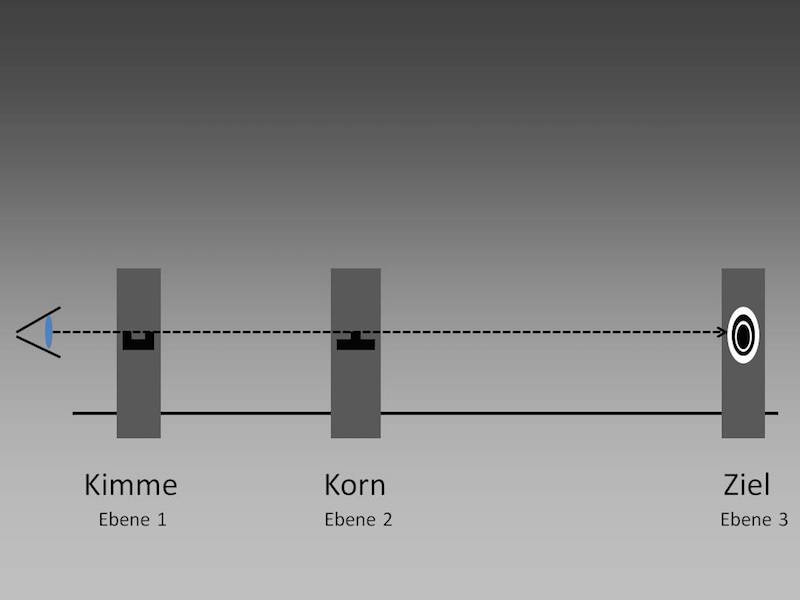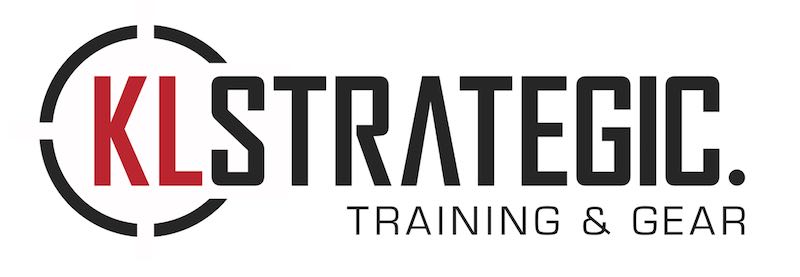Hol Dir den wöchentlichen SPARTANAT-Newsletter.
Dein Bonus: das gratis E-Book von SPARTANAT.
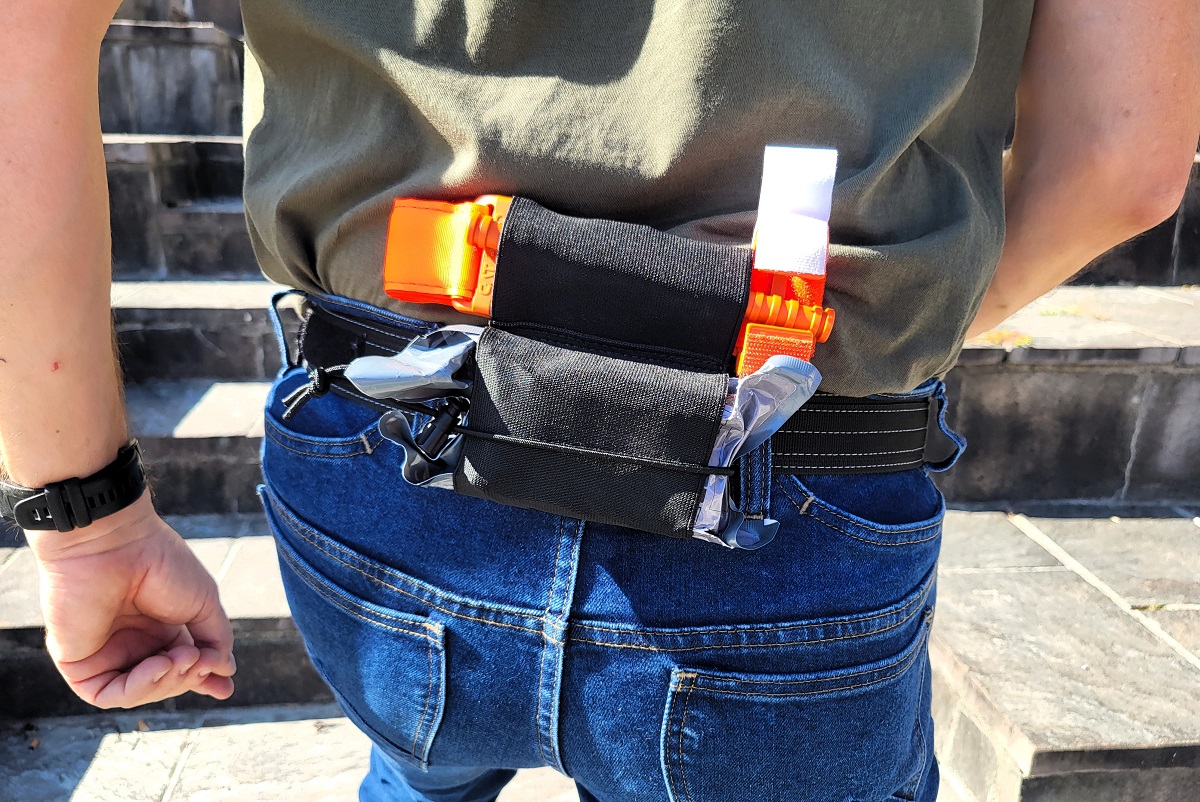
TRAINING MIT KL STRATEGIC (7.1): Zielen – die Gretchenfrage
Das Zielen ist definiert als der Vorgang des Ausrichtens der Waffe auf einen vordefinierten Punkt, mit der Absicht, bei der Schussauslösung diesen Punkt mit dem Geschoss zu treffen. So einfach dies klingt, so schwierig stellt sich dieser Vorgang in der Realität dar.
Das Zielen ist definiert als der Vorgang des Ausrichtens der Waffe auf einen vordefinierten Punkt, mit der Absicht, bei der Schussauslösung diesen Punkt mit dem Geschoss zu treffen.
So einfach dies klingt, so schwierig stellt sich dieser Vorgang in der Realität dar. Insbesondere offene Visierungen stellen hierbei an den Schützen gesteigerte Anforderungen. Dieser siebte Teil der Artikelserie beschäftigt sich im ersten Abschnitt mit dieser Problematik.
Als offen wird eine Visierung immer dann bezeichnet, wenn die Zielvorrichtung aus mehreren Elementen besteht, die in unterschiedlichen Entfernungen zum Auge des Schützen platziert sind und dort aktiv für den Zielvorgang genutzt werden; in der Regel Kimme/Diopter und Korn. Bauartbedingt werden bei diesen offenen Visierungen mehrere Bildebenen genutzt, welche sich in unterschiedlichen Entfernungen zum Auge des Schützen befinden:
- Ebene = Kimme/ Diopter
- Ebene = Korn
- Ebene = Ziel
Das menschliche Auge kann diese unterschiedlich entfernten Bildebenen zwar gleichzeitig darstellen, jedoch nicht alle gleichzeitig scharf konturiert abbilden. Somit stellt sich dem Schützen die erste grundlegende Frage:
Welches Element der Visiereinrichtung soll scharf sein?
Um diese Frage zu beantworten bedarf es einer genauen Einschätzung der eigenen Fertigkeiten und die Kenntnis über den Trainingsstand. Weiterhin ist die Beantwortung dieser Frage situationsabhängig. Ich versuche im Folgenden diese Frage unter diesen Gesichtspunkten zu beantworten.
Beginnen wir zunächst mit dem Aspekt der eigenen Fertigkeiten. Der Schusswaffenumgang ist immer als Gesamtablauf zu sehen, was bedeutet, dass auch das Zielen mit den anderen vier grundlegenden Schießelementen verknüpft ist.
Für Anfänger und diejenigen, die explizit auf den Zielvorgang trainieren wollen, sowie diejenigen, die realistisch betrachtet sagen, dass die Fertigkeiten im Schusswaffenhandling nicht so gut sind, wie sie es gerne hätten, empfiehlt es sich, beim Zielen mit offenen Visierungen zwischen den Bildebenen hin und her zu fokussieren. Dies bedeutet, dass der Fokus – also das Scharf stellen der jeweiligen Bildebene – immer wieder wechselt zwischen Kimme/Diopter, Korn und Ziel.
Hierbei ist stets zu kontrollieren, dass die Ausrichtung von Kimme und Korn zueinander sowie die Ausrichtung der Waffe/Visierung auf das Ziel, genauer gesagt, den Haltepunkt korrekt ausgeführt werden und unter Beachtung der anderen Schießelemente während der Schussabgabe auch bleiben. Je nach Fortschritt/ Schwerpunkt im Training des Zielens wechselt der Fokus im Moment der Schussauslösung.
| Trainingsschwerpunkt | Voraussetzung | Fokus im Moment der Schussauslösung |
| Ausrichtung Kimme- Korn | Korrekte Abzugsarbeit | Kimme: korrekte Platzierung des Korns in der Kimme |
| Verreißen | Ausrichtung Kimme/Korn i.O. | Korn: Halten des Haltepunktes während der Schussauslösung |
| Abkommen | Korrekte Abzugsarbeit und Visierausrichtung | Haltepunkt im Ziel: Kontrolle des Abkommens vom Haltepunkt |
Es ist im Besonderen darauf zu achten, die „klassischen“ Zielfehler zu vermeiden. Dies wird durch das Fokussieren der einzelnen Elemente und der damit verbundenen Kontrolle der Ausrichtung zueinander ermöglicht. Diese Zielfehler sind:
- Seitliches Klemmen
- Vollkorn
- Feinkorn
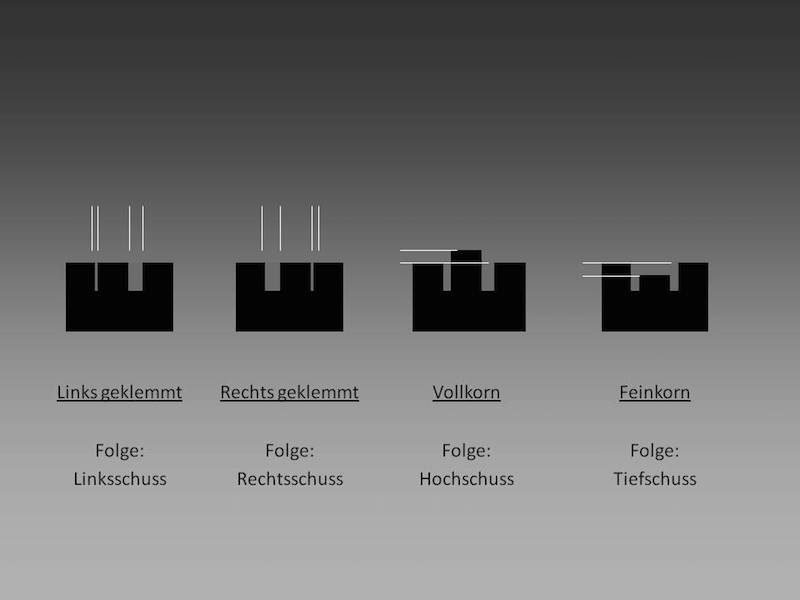 Nicht nur für Anfänger und Schützen, die sich im Zielvorgang speziell trainieren wollen ist diese Methode sinnvoll. Situationsabhängig wird diese Methode empfehlenswert, oder auch dringend notwendig. Hierzu tauchen wir ein wenig tiefer in die die Methodik des Zielens und die zugehörigen biomechanischen Aspekte ein:
Nicht nur für Anfänger und Schützen, die sich im Zielvorgang speziell trainieren wollen ist diese Methode sinnvoll. Situationsabhängig wird diese Methode empfehlenswert, oder auch dringend notwendig. Hierzu tauchen wir ein wenig tiefer in die die Methodik des Zielens und die zugehörigen biomechanischen Aspekte ein:
Im stressresistenten Schusswaffenumgang unterteilen wir die Entfernungen zu einem Ziel in unterschiedliche Bereiche; den reaktiven Bereich und den nicht reaktiven Bereich. Diese Unterteilung richtet sich nach Art der genutzten Waffe ( Langwaffe, Kurzwaffe) der genutzten Visierung und vor allem nach den persönlichen Fertigkeiten des Schützen. Letzter Aspekt ist ausschlaggebend.
 Vom reaktiven Bereich spricht man bei einer Zielentfernung von 0 bis ca. 7-10m. Die genaue Definition ist fertigkeitsabhängig. In diesem Bereich ist ein Zielen relativ, da hier die Ausrichtung der Waffe – mit den entsprechenden Fertigkeiten – intuitiv erfolgt. Je nach notwendiger Genauigkeit des Schusses kann jedoch auch hier ein genaues Zielen mit Ausrichtungskontrolle nötig sein.
Vom reaktiven Bereich spricht man bei einer Zielentfernung von 0 bis ca. 7-10m. Die genaue Definition ist fertigkeitsabhängig. In diesem Bereich ist ein Zielen relativ, da hier die Ausrichtung der Waffe – mit den entsprechenden Fertigkeiten – intuitiv erfolgt. Je nach notwendiger Genauigkeit des Schusses kann jedoch auch hier ein genaues Zielen mit Ausrichtungskontrolle nötig sein.
Der nicht reaktive Bereich ist jede Zielentfernung ab der Obergrenze des reaktiven Bereiches bis hin zur maximalen Reichweite der jeweiligen Waffe. Hier wird mit zunehmender Entfernung die Notwendigkeit eines genauen Zielens immer größer. Hier ist also die Nutzung des wechselnden Fokus zur Kontrolle der korrekten Visierausrichtung empfehlenswert.
Je weiter ein Objekt vom Auge entfernt ist, um so mehr Zeit wird benötigt, um dieses scharf zu fokussieren. Dies ist biomechanisch begründet. Zum fokussieren weiter entfernter Objekte müssen die Muskeln in den Augen entspannt werden, wohingegen nah liegende Objekte durch Kontraktionen der Augenmuskeln fokussiert werden. Die Entspannung geht jedoch langsamer von Statten, als die Kontraktion, so dass hierfür mehr Zeit in Anspruch genommen wird. Ein weiterer „Zeitfresser“ ist die biomechanische Methode des Fokussierens im menschlichen Auge. Während im Nahbereich die Stellung der Augen zueinander sowie die Muskelkontraktion zur Fokussierung relativ kleinschrittig abläuft, sind weiter entfernte Objekte mit einem größeren Aufwand zu fokussieren. Hierbei wird zunächst über das Objekt hinaus fokussiert, um danach vor das Objekt zu fokussieren und dann die Muskulatur langsam zu entspannen und den Fokus so korrekt auf das Objekt zu bringen.
Dieser Vorgang läuft zwar innerhalb eines kurzen Zeitraumes ab, ist jedoch deutlich länger als das Fokussieren im Nahbereich. Auf der anderen Seite bietet diese Methode aber deutlich genauere „Ergebnisse“.
Nun stellt sich die nächste Frage:
Wie kann ich als erfahrener Schütze den Zielvorgang beschleunigen?
Die Beantwortung dieser Frage ist primär sehr einfach: ÜBEN, ÜBEN, ÜBEN.
Jedoch gibt es eine Methode für Fortgeschrittene, die ein hohes Level der Fertigkeiten und ein Beherrschen der Schießelemente voraussetzt. Erfüllt man diese Kriterien, kann diese Methode jedoch sehr viel Zeit beim Zielen einsparen.
Die Methode nennt sich „Korn scharf- Zielen“.
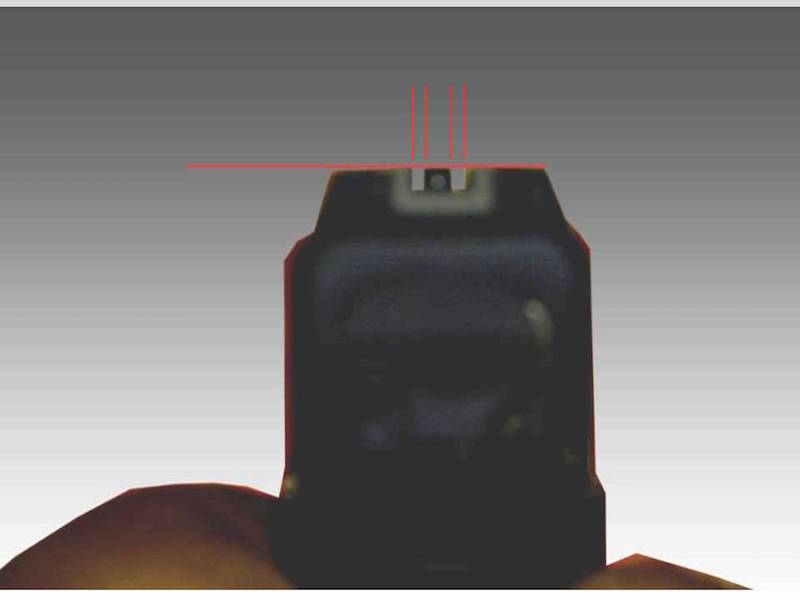 Im Grunde genommen ist diese Technik recht einfach. Man fokussiert das Korn scharf und bringt dieses dann in das Ziel. So einfach sich dies anhört, so schwierig ist die Umsetzung. Voraussetzung für die erfolgreiche Anwendung dieser Methode ist es, dass man sich darauf verlassen kann, die Waffe gerade und korrekt ausgerichtet in den Anschlag bringen zu können und den Bereich des Korn gleich scharf fokussiert zu sehen. Hierzu wird Der Bereich, in dem das Korn im Anschlag sein wird fokussiert, um im Anschlag sofort das Korn selber durch Kontraktion der Augenmuskulatur scharf zu sehen. Kimme und Ziel sind dabei unscharf. Dies erfordert sehr viel Übung. Die meisten neigen – insbesondere mit Kurzwaffen dazu – Vollkorn zu schießen, da das Korn zur Sicherheit deutlich gesehen werden soll. Dies führt dazu, die Waffe mit der Mündung leicht anzuheben, um ein Verdecken des Korns durch die Kimme zu verhindern. Darauf ist beim Training dieser Methode besonders zu achten. Die Methode an sich basiert darauf, dass das menschliche Auge zwar nur einen Bildebene scharf fokussieren, aber trotzdem mehrere Bildebenen gleichzeitig darstellen kann. Kimme und Ziel werden hierbei unscharf abgebildet, jedoch reicht dies aus, um bei korrekten Rahmenbedingungen (Schießelemente) Treffbereiche zuverlässig zu beschießen. Mit der Methode „Korn scharf“ ist es möglich, fast intuitiv zu schießen. Somit kann diese Methode den reaktiven Bereich deutlich vergrößern, was für das Reaktionsschießen von Berufswaffenträgern und auch für dynamische Sportschützen von Vorteil ist.
Im Grunde genommen ist diese Technik recht einfach. Man fokussiert das Korn scharf und bringt dieses dann in das Ziel. So einfach sich dies anhört, so schwierig ist die Umsetzung. Voraussetzung für die erfolgreiche Anwendung dieser Methode ist es, dass man sich darauf verlassen kann, die Waffe gerade und korrekt ausgerichtet in den Anschlag bringen zu können und den Bereich des Korn gleich scharf fokussiert zu sehen. Hierzu wird Der Bereich, in dem das Korn im Anschlag sein wird fokussiert, um im Anschlag sofort das Korn selber durch Kontraktion der Augenmuskulatur scharf zu sehen. Kimme und Ziel sind dabei unscharf. Dies erfordert sehr viel Übung. Die meisten neigen – insbesondere mit Kurzwaffen dazu – Vollkorn zu schießen, da das Korn zur Sicherheit deutlich gesehen werden soll. Dies führt dazu, die Waffe mit der Mündung leicht anzuheben, um ein Verdecken des Korns durch die Kimme zu verhindern. Darauf ist beim Training dieser Methode besonders zu achten. Die Methode an sich basiert darauf, dass das menschliche Auge zwar nur einen Bildebene scharf fokussieren, aber trotzdem mehrere Bildebenen gleichzeitig darstellen kann. Kimme und Ziel werden hierbei unscharf abgebildet, jedoch reicht dies aus, um bei korrekten Rahmenbedingungen (Schießelemente) Treffbereiche zuverlässig zu beschießen. Mit der Methode „Korn scharf“ ist es möglich, fast intuitiv zu schießen. Somit kann diese Methode den reaktiven Bereich deutlich vergrößern, was für das Reaktionsschießen von Berufswaffenträgern und auch für dynamische Sportschützen von Vorteil ist.
Wie bereits angesprochen, basiert diese Technik auf verlässlichen und ausgeprägten Fertigkeiten des Schützen. Sofern Griff, Anschlag, Atmung und Abzugsverhalten nicht zu 100% passen, wird man mit dieser Methode wenig Erfolg haben. Geübte und trainierte Schützen können mit dieser Methode jedoch sehr schnell auch auf mittlere Distanzen noch relativ kleine Zielbereiche auch unter erschwerten Bedingungen (aus dem Holster, aus der Drehung, aus der Bewegungn, etc.) verlässlich treffen. So ist z.B. mit dieser Methode das Treffen eines Zielbereiches von 7 cm Durchmesser aus einer Entfernung von 10m mit einer Kurzwaffe aus dem Holster innerhalb von 1,5 Sekunden (Reaktionsschießen) ohne Weiteres möglich.
Nun zu der viel diskutierten und grundsätzlichsten Frage überhaupt:
Beide Augen offen, oder eines geschlossen?
Diese Frage hat schon zu manchem Streit geführt und jeder hat seine eigene Meinung dazu. Grundsätzlich sage ich meinen Kursteilnehmern immer, dass sie das machen sollen, was ihnen am besten passt, also das, was für sie funktioniert. Am Ende entscheidet der Erfolg über Richtig oder Falsch.
Es gibt jedoch einige grundlegende Faktoren, die man bedenken sollte:
- Die Entscheidung ist abhängig von der genutzten Visierung. Offene Visierungen ermöglichen grundsätzlich beide Varianten. Rotpunktvisiere sind dazu gedacht, im räumlichen Sehen eine Zielmarkierung in das Sehfeld des Schützen zu projizieren, daher hat es hier keinen Sinn, ein Auge zu schließen. Zielfernrohre sind für größere Entfernungen gedacht und bedürfen daher keines räumlichen Sehens, sondern einer genauen Ausrichtung des Absehens auf das Ziel. Hier ist also das Schließen des nicht zielenden Auges zweckmäßig.
- Die Entfernung zum Ziel sowie die Größe des Zielbereiches sind ausschlaggebend. Gerade bei offenen Visierungen haben schon geringe Abweichungen einen großen Einfluss auf die Flugbahn des Geschosses und letztendlich darauf, ob man das trifft, was man treffen will. Das bedeutet also, dass es eine gewisse Zielentfernung – abhängig von der eigenen Fertigkeiten – gibt, bei der es sinnvoll ist, auf das räumliche sehen zu verzichten und den Schwerunkt auf eine genau Visierausrichtung zu legen; sprich ein Auge zu schließen.
- Die Situation diktiert das Verhalten. Je nach Situation muss man als Schütze entscheiden, wie man zielt. Für dynamische Situationen, bei denen es auf schnelle Reaktionen bei gleichzeitigem räumlichen Sehen ankommt, ist die Methode mit beiden Augen offen zu zielen zu bevorzugen. Ab einer gewissen Distanz gilt Pkt. 2. Reaktionsschießen kann grundsätzlich nur mit beiden Augen offen erfolgen, da es hier um schnelle Zielauffassung und relativ große Zielbereiche geht.
Zu diesen Punkten kommen noch weitere Aspekte wie Augendominanz, Verhalten des Zieles, eigenen Gefährdungslage usw. Fakt ist jedoch, dass es primär darum geht, einen sicheren Schuss abzugeben unter Berücksichtigung aller einflussnehmenden Parameter. Ob nun mit beiden Augen offen oder einem geschlossen ist dabei dann relativ egal, solange das erwünschte Ziel erreicht wird. Die Entscheidung liegt also bei jedem Schützen selbst. Erfahrungsgemäß zeigt sich bei Kursen folgende Tendenz:
Anfänger schießen mit einem Auge geschlossen auf alle Entfernungen. Mit zunehmenden Fertigkeiten wird im Nahbereich öfter mal mit beiden Augen offen geschossen. Dynamische Schützen tendieren dazu, erst ab Entfernungen jenseits der 15m ein Auge zu schließen und somit die Präzision zu erhöhen. Bei den ersten Versuchen des Wechsels zu „Beide Augen offen“ verschlechtern sich zunächst die Trefferergebnisse, was ganz natürlich ist. Davon sollte man sich nicht entmutigen lassen.
Für die Thematik „Zielen mit offenen Visierungen“ fasse ich also noch mal zusammen:
Beim Training des Zielens und für Anfänger empfiehlt es sich, zunächst zwischen den Bildebenen in und her zu fokussieren, um eine korrekte Visierausrichtung zu gewährleisten. Dies gilt im Übrigen auch dafür, wenn man einen neue Waffe, einen neue Visierung oder eine geänderte Visiereinstellung hat.
Geübte Schützen können die Methode „Korn scharf“ nutzen, um die Zeit für den Zielvorgang zu optimieren, müssen sich aber auf Ihre Fertigkeiten in der Anwendung der übrigen Schießelemente 100% verlassen können, um effektiv und effizient arbeiten zu können.
Die Frage ob mit beiden Augen offen oder einem Auge geschlossen zu zielen ist bei offenen Visierungen rein akademisch und hängt ab von persönlichen Eigenheiten, Vorlieben und den eigenen Fähigkeiten.
All diese Angeben basieren auf Erfahrungen und Untersuchungen. Es wird immer jemanden geben, auf den Ergebnisse von wissenschaftlichen Untersuchungen nicht genau oder gar nicht zutreffen/anwendbar sind. Ich hoffe jedoch, hier grundlegende Möglichkeiten aufgezeigt zu haben, die es ermöglichen, für sich selber eine passende Methode zu finden.
Mein Tip: Selber ausprobieren – der Erfolg gibt Recht. Bei Fragen jemanden suchen, der sich auch auskennt.
In diesem Sinne
Khi Pa
Teil1: Alles im Griff
Teil2: Der Anschlag
Teil3: Der natürliche Haltepunkt
Teil4: Die Augendominanz
Teil5: Die Abzugsarbeit
Teil6: Der Arbeitsbereich
Teil7.1: Zielen, die Gretchenfrage
Teil7.2: Zielen, alles auf den Punkt gebracht
Teil7.3: Was Tun Mit Zielfernrohren
Teil8: Sichere Ladetechniken für Pistolen und Revolver
Teil9: Sichere Ladetätigkeiten für Flinten
Teil10: Sichere Ladetätigkeit mit der Selbstladebüchse
Teil11: Alles über Ausrüstung
Teil12: Heimtraining
KL STRATEGIC im INTERNET: http://kl-strategic.com
KL STRATEGIC auf FACEBOOK: www.facebook.com/KL-STRATEGIC
SPARTANAT ist das Online-Magazin für Military News, Tactical Life, Gear & Reviews.
Schickt uns eure News: [email protected]
Werbung
Hol Dir den wöchentlichen SPARTANAT-Newsletter.
Dein Bonus: das gratis E-Book von SPARTANAT.


